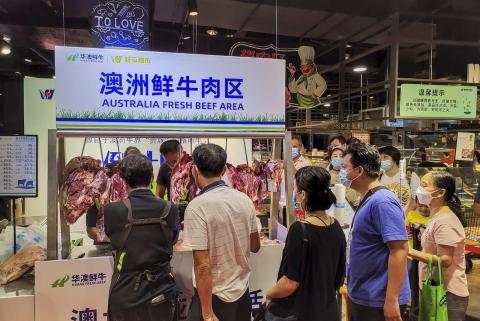When the City of Sydney issued a statement after cancelling a Mao commemoration concert planned for this week, it cited concerns over public safety, the potential for civil disturbance, insufficient planning, and a lack of control over ticketing. It did not mention the public opposition to the event, or wider concerns about China's increasing influence over the local community. For its part, the City of Melbourne described its move to pull the plug on the Mao event scheduled for its town hall simply as a 'decision of the organisors'. The reticence by both was understandable – it's a smart way to stay friendly with Beijing authorities – but one wonders how earlier incarnations of these councils would have viewed the response, given the role they played in fostering strong communities with international influence.
Sydney and Melbourne have been home to Chinese Australian nationalists and patriots since the late 19th century. This patriotism was not always rooted in love and loyalty to China and local governments in the two cities helped the Chinese communities to learn and adopt democratic values, even before Australian Federation.

Sydney Town Hall circa 1890 (Photo: Getty Images)
In 1897, for example, there was a spirited public backlash in Sydney against a plan to turn part of Hyde Park into a railway station. Sydney’s then mayor Isaac Ives presided over a number of public meetings at the Town Hall that sought to keep the Park intact. Sydney’s first Chinese-language newspaper – the Chinese Australian Herald (CAH) – reported this public campaign as a 'model of democracy'. Later in the same year, CAH worked with both Chinese and wider Australian committees to participate in to the Queen’s Diamond Jubilee Charity Carnival. The CAH hoped to persuade its Chinese readers to embrace the British Queen as part of improving relations between the Chinese community and the colonial political authorities.
In 1899, Sydney’s second Chinese-language newspaper – the Tung Wah News – helped establish the Chinese Empire Reform Association (??? Baohuanghui). This was an international organisation of monarchists who supported democracy as a method of improving China. For six months to April 1901, Liang Qichao, the second in command of this group of Chinese reformers, visited Australia and in January 1901, he participated in Sydney Town Hall events to celebrate Australian Federation.
In the first decades of the 20th century, Sydney's local governance and social welfare institutions were used as a model by a group of Chinese nationalists who sought to apply these institutions to their home villages in the Guangdong province in South China.
In 1918, Chinese community leaders felt slighted after Sydney City Council failed to acknowledge their home country’s contributions to the war effort in flag-raising ceremonies that marked the end of the World War One. The council responded promptly to the complaint, and the flag of the new Chinese Republic was flown over Sydney Town Hall for the first time. [fold]
In Melbourne, the first pro-revolution Chinese newspaper in Australia, the Chinese Times, was published in 1902. Its editor, Thomas Chang Luke, launched the China Public Association at the Melbourne Temperance Hall in 1904. The Association held public lectures on patriotism, paying particular attention to the subjects of God and Confucianism and telling Chinese Australians that, because of their experience of Western knowledge and modernity, it was their duty to enlighten China.
Chang Luke, like many other Chinese Australian nationalists, was baptised as a Protestant. It is worth noting that in 1904 he translated a favourable review of a speech of Mrs Anne Fraser Bon given in her home at Kew. Mrs Bon was a philanthropist and a member of Board for the Protection of the Aborigines, an organisation supported by local government. The Chinese Times published her speech and encouraged its readers to embrace her ideas about equality, democracy and freedom. The connection between Mrs Bon and the Chinese Public Association in Melbourne reflects the impact that local Melbournians had on Chinese political engagement. In 1920, when Melbourne's Chinese nationalists opened their own hall, city councillors attended the event. An official history book of the Chinese Nationalist Party of Australasia (Kuo Min Tang) published in 1935 stated that Melbourne was the origin of Chinese Republic in Australia.
Melbourne living conditions, many of which were directly and indirectly influenced or maintained by local government, also inspired local Chinese. Letters sent home by a Chinese student, Joe Tong, from Melbourne in the post-WWI period for example spoke highly of the city’ s efficient public education system, about the varieties of goods and foodstuff available through department stores and shops, the city’ s public transport system, public hospitals, the provision of social welfare for the poor, and the general lifestyles of the people of Melbourne.
Both cities thus have a proud history of inspiring and fostering strong, engaged and democratic Chinese communities. Rather than distancing themselves from disputes such as those caused by the planned Mao concerts, they should continue to engage with Chinese communities and demonstrate the kind of democratic, civic processes that have inspired Chinese Australian communities for more than a century.
Simply cancelling Mao’s memorial concerts does not address the issues causing public concern and community division. If city authorities want to inspire and foster strong, engaged and democratic Chinese communities then, rather than distancing themselves from disputes such as these, they need to engage with Chinese communities and inspire them with the kind of democratic, civic processes that inspired Chinese Australian communities in the early 20th century.
